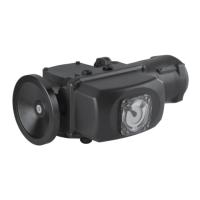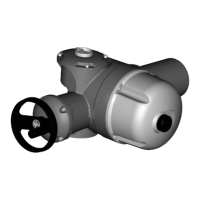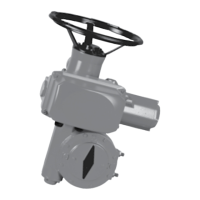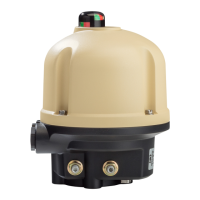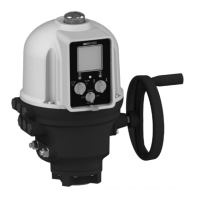34 35
26.2 SETTING OF DEADBAND VALUE
The deadband value is the maximum allowable difference between the signal and the actuator
position when no action occurs.
This setting is made at the factory, but it is possible to adjust it.
If the deadband is too narrow, the actuator could start hunting, i.e opening and closing around the
expected position without being able to stabilise. If the deadband is too wide, positioning actions
are less precise.
The default deadband setting is 1%.
Select dead band % in the POSITIONER menu and turn to OK to confirm.
Use the blue selector to increase or decrease the value. Turn to OK to confirm.
26.3 FAIL-SAFE POSITION
When a 4-20 mA input signal is used, it is possible to set up a fail-safe position for use if the control
signal is lost.
Caution: this function cannot be used with 0-20 mA signals, as the system cannot distinguish
between a lost signal and a 0 mA value.
This function is active in the standard configuration, and the
actuator remains in position if the signal is lost.
The user can also choose open or close. Select lost
signal in the POSITIONER menu and turn to OK
to confirm. Select the action required and turn to OK to confirm.
26.4 PROPORTIONAL PULSE MODE
INTELLI+ incorporates a positioning mode which takes account of the actuator’s inertia. If the move-
ment time is too short or if the motor has excessive inertia, positioning can be improved by selecting
proportional pulse mode.
INTELLI+ calculates and corrects the motor’s stopping point to reach the expected position and then
applies pulses proportional to any deviation if necessary.
This mode is used for relatively stable control actions where partial compensation can be made the
actuator’s inertia. The actuator is cycled more often than with a standard command.
Select proportional pulse in the POSITIONER menu and turn to OK to confirm. Select (no) or (yes)
and turn to OK to confirm.
27 USING FIELDBUS CONTROL (DEPENDING ON MODEL)
The fieldbus interface is used for sending commands and data over a single line. Specific docu-
mentation details methods for addressing individual actuator and provides a list of addresses for
accessing all commands or data sources.
The type of interface is shown in the menu.
Lost communication can be used to configure the fail-safe po-
sition. This function is active in the standard configuration, and
the actuator remains in position if communication is lost.
The user can also choose open or close.
Select change in the MENU and turn to OK to confirm
Select bus in the CHANGE menu and turn to OK to confirm.
Select lost communication in the BUS menu and turn to OK
to confirm.
Select the action required and turn to OK to confirm.
LOST SIGNAL
(closing
(stayput)
(opening)
PROFIBUS
return
lost communication
Cmd by fieldbus
slave number
return
LOST COMMUNIC
(closing)
(stayput)
(opening)
Bus control: Bus control is normally selected. For equipment which also uses a standard hard-
wired system, this configuration allows the user to chose the command mode: either via bus
or hard-wired (see §7.1 and §7.2)
Slave no. Actuator address. All actuators have to have different addresses.
The default address is 2.
Refer to specific documentation for further details on fieldbus interfaces commissionning.
28 USING IN CASE OF POWER SUPPLY LOST (WITh BATTERY DEPENDING
ON MODEL)
Depending on the actuator model, the battery option allows to display the position when the power
supply is off. When the power supply is off, the actuator goes into standby mode with very low
power consumption.
Regular tests allow to check the valve position, if the position changed the relays are updated.
- In case of actuator with position feedback the position
is updated.
- In case of fieldbus communication, the fieldbus board
is supplied (5s) to allow the PLC bus controller to read
the new position.
When the power supply is off the display can be read but it cannot possible to navigate into the menu.
To wake up the system and illuminate the display, you must act on the command button blue
as to give an order to close. The “low battery” information can be read at any time on the display
or by remote signalling. The display will be shut down after 30 secondes without activity.
- Temperature: 40°C (For different temperatures (above or below) the life expectancy may be reduced)
Note: even without the battery the
actuator operates without risk
of loss or configuration of its position
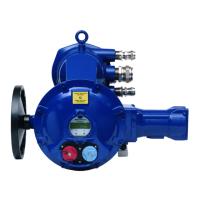
